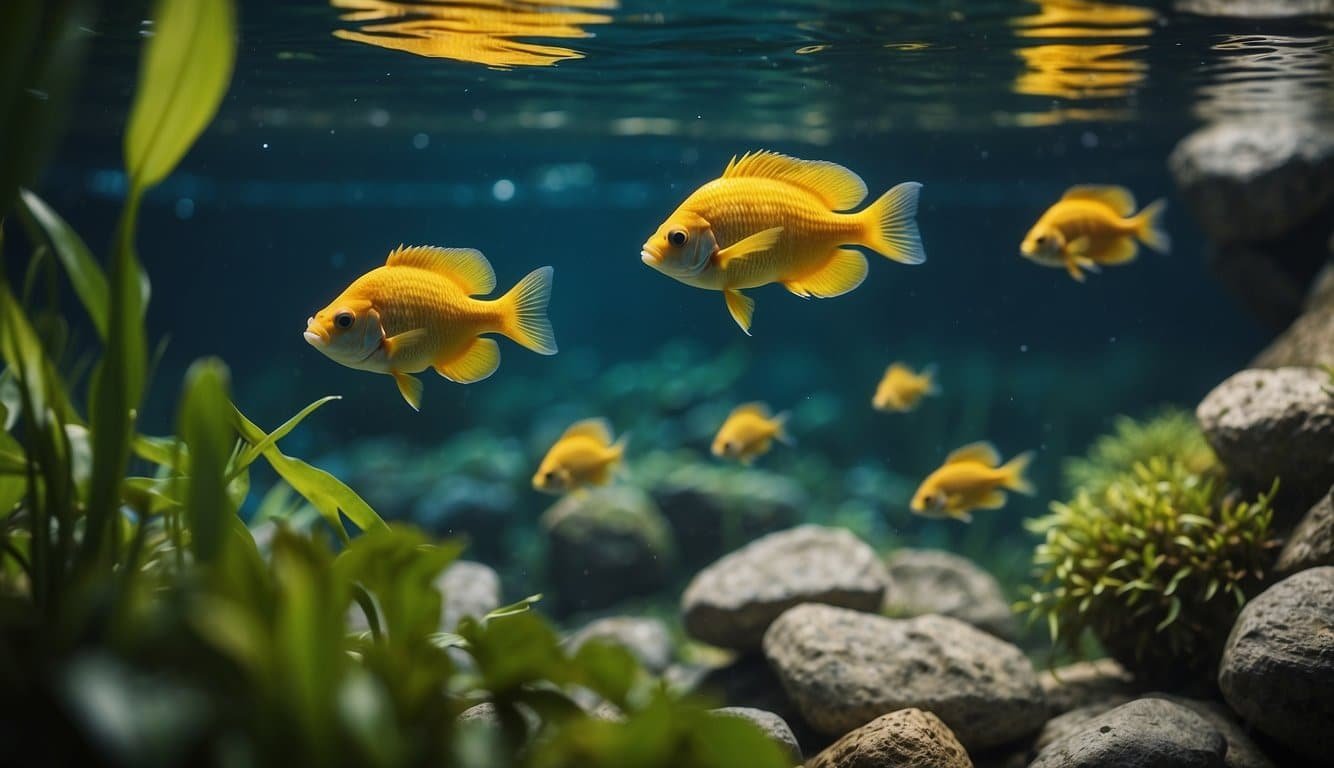Understanding Freshwater Fish
Freshwater fish are a diverse group of vertebrates that thrive in a variety of watery habitats. They’ve adapted physiologically to live in the distinctive environments of rivers, lakes, and wetlands, which present unique challenges such as fluctuating temperature and oxygen levels.
Defining Freshwater Fish
Freshwater fish are species that spend most, if not all, of their lives in bodies of fresh water, like rivers and lakes, with low salinity levels. Unlike their marine counterparts, these fish can’t tolerate high salt concentrations. They belong to a group of vertebrates and are known for their ability to regulate their internal conditions, such as temperature and salinity.
Common Freshwater Habitats
Freshwater habitats for these fish include:
-
Rivers: Flowing bodies of water that move in one direction.
-
Lakes: Larger bodies of standing water, often fed by rivers and streams.
-
Wetlands: Areas where water covers the soil or is present at or near the surface for varying periods of time.
Each habitat brings its own set of temperature and oxygen variations, necessitating different survival strategies among freshwater fish species residing there.
Physiological Adaptations
To thrive in their habitats, freshwater fish have:
- Gills: Specialized for efficient oxygen extraction from water.
- Scales: That protect them from injuries, parasites, and infections.
- Kidneys: Adapted to maintain the right balance of water and electrolytes.
These physiological traits help them to withstand changes in water temperature and oxygen levels that characterize fresh water ecosystems.
For those eager to dive deeper into the subject, Patterns in freshwater fish ecology showcases the diversity of fish forms, and how understanding individual traits can influence the larger scope of fish ecology. To comprehend how fish respond to drought and other environmental stresses, reading about the responses of freshwater fish could be quite enlightening. For those curious about conservation, insights on why freshwater fish are so threatened provide a compelling read.
Diversity of Freshwater Fish Species

Freshwater fish inhabit a vast range of aquatic environments worldwide, showcasing a spectacular variety of species. Each body of water, from the smallest stream to the largest lakes, harbors a unique community of fish, adapted to their freshwater homes.
In the waters of North America, one might encounter species such as the energetic largemouth bass, an utmost favorite among anglers. Their wide mouths are indicative of their predatory lifestyle, ambushing prey from their lurking spots among submerged vegetation. North America is also home to a multitude of trout and salmon species, many of which are anadromous, meaning they migrate to the ocean and return to freshwater to spawn.
Venturing into South America, the diversity evolves with the strikingly beautiful cichlids, which are highly sought after for freshwater aquariums due to their vibrant colors and interesting behavior. The Amazon Basin alone is teeming with life, hosting species such as the armored catfish and the ever-popular tetras, small but full of character.
Freshwater ecosystems also include both native and non-native species, with the latter sometimes posing a threat to the ecological balance. Non-natives like certain plecos species have been introduced into regions outside of their native habitat, often accidentally through the aquarium trade.
Many freshwater fish are facing conservation challenges; some are endangered or even on the brink of extinction due to habitat loss, overfishing, and pollution. Protecting these aquatic treasures and their habitat is essential for maintaining the biodiversity that makes freshwater fisheries so intriguing and vital to our world.
For more curious facts about these freshwater dwellers, one might look into studies on Global diversity of fish in freshwater, or reports on the Patterns in freshwater fish diversity, each presenting a wealth of information on this fascinating topic.
Conservation and Environmental Impact

When it comes to freshwater fish, conservation efforts are vital. Various factors contribute to the decline of fish populations, including habitat destruction, overfishing, and the introduction of invasive species. In regions like the Amazon, which harbors a vast array of freshwater species, the impact of human activity has led to notable habitat loss.
Habitat Loss: The United States has seen significant changes in its waterways, with states such as Alabama, Tennessee, and Florida experiencing habitat destruction that affects native species. This disruption often comes from urban development, pollution, and alterations to river flows.
Human Activity: Overfishing is another human-induced threat to freshwater fish. It can disrupt the natural balance of ecosystems, leading to decreased populations and even jeopardizing entire species. Invasive species, often introduced accidentally through global trade or the aquarium trade, outcompete native fish for resources and space.
Conservation Efforts: There are numerous initiatives aimed at conserving freshwater habitats and their inhabitants. These include creating protected areas, restoring degraded ecosystems, regulating fishing practices, and controlling invasive species.
Algae’s Role: Interestingly, algae play a crucial part in maintaining healthy freshwater ecosystems. They are a primary source of oxygen in water bodies and serve as a fundamental part of the food chain.
Ensuring the sustainability of freshwater fish requires ongoing global efforts to address these environmental impacts. By understanding the challenges, everyone can contribute to the conservation of these aquatic communities. Read more about fish conservation practices and the importance of environmental impact assessments for freshwater fish biota.

